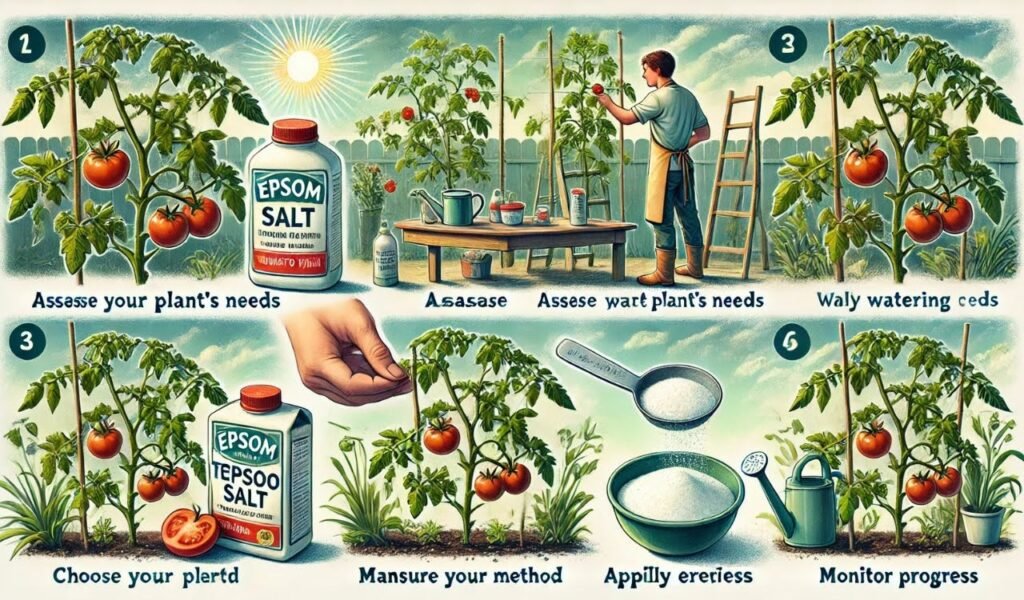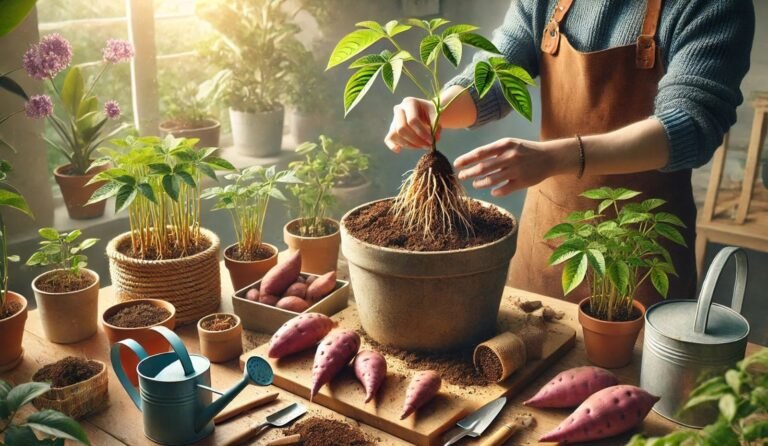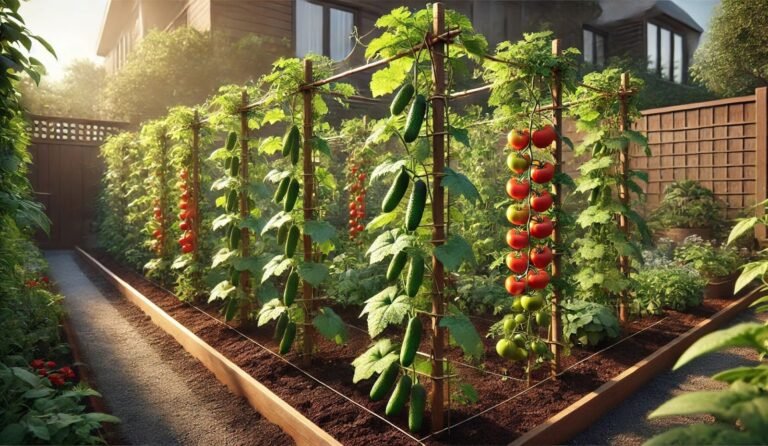How Much Epsom Salt for Tomato Plants to Boost Growth Fast
How much Epsom salt for tomato plants is the secret to bigger, healthier harvests? If you’re wondering whether a sprinkle of this miracle ingredient can transform your tomatoes, you’re not alone. Used the right way, Epsom salt can tackle common plant problems like yellow leaves and slow growth. But how much is too much? And when’s the perfect time to use it? Let’s break it down so your tomatoes thrive like never before!
What Is Epsom Salt?
Epsom salt, also known as magnesium sulfate, is a naturally occurring mineral compound made up of magnesium, sulfur, and oxygen. Unlike table salt, Epsom salt doesn’t contain sodium, making it ideal for gardening.
Why Are Magnesium and Sulfur Important for Tomato Plants?
Magnesium is crucial for photosynthesis, helping plants create energy from sunlight. It also aids in the absorption of other nutrients like nitrogen and phosphorus, which are essential for plant health. Sulfur, on the other hand, helps build strong plant proteins and supports enzyme production.
For tomatoes, magnesium is particularly important during the flowering and fruiting stages, ensuring strong, vibrant plants with higher yields. Sulfur further enhances flavor and plant resilience, making Epsom salt a valuable tool in the gardener’s toolkit.
Is Epsom Salt Good for Tomato Plants?
Yes, But Why?
Epsom salt is beneficial because it directly addresses magnesium deficiencies, a common problem in tomatoes. Deficiency symptoms, such as yellowing leaves between the veins (interveinal chlorosis), are quickly resolved with magnesium supplementation. Tomatoes often need extra magnesium, especially during periods of rapid growth, flowering, or fruit production.
Additionally, Epsom salt:
- Improves the health of leaves, making them greener and more robust.
- Enhances flowering and fruit setting, contributing to higher yields.
- Helps plants recover from stress caused by transplanting or environmental changes.
What It Doesn’t Do
It’s important to debunk some myths about Epsom salt:
- It does not prevent blossom-end rot. This condition is caused by a calcium deficiency, not magnesium, so adding Epsom salt won’t help.
- It’s not a substitute for balanced fertilizers. Tomatoes need a range of nutrients, including nitrogen, potassium, and calcium, which Epsom salt doesn’t provide.
Think of Epsom salt as a supplement, not a one-stop solution.
How Much Epsom Salt for Tomato Plants?
For Soil Application
When planting tomatoes in the ground, mix 1 tablespoon of Epsom salt per foot of plant height into the soil. This ensures the roots can absorb magnesium as they grow. During the growing season, you can add a mid-season boost by sprinkling 1 tablespoon of Epsom salt around the base of each plant and watering it in.
For Foliar Spray
For a quick magnesium boost, use a foliar spray by dissolving 1-2 tablespoons of Epsom salt in a gallon of water. Spray this solution directly onto the leaves in the early morning or late evening to avoid sunburn. This method is particularly effective if plants show signs of magnesium deficiency.
For Potted Tomato Plants
Potted plants need less Epsom salt because of their confined soil volume. Use ½ tablespoon of Epsom salt per gallon of soil when planting. Repeat every four weeks to replenish magnesium levels.
How to Add Epsom Salt to Tomato Plants

Here’s a simple step-by-step guide to applying Epsom salt:
- Assess Your Plant’s Needs: Look for signs of magnesium deficiency, such as yellowing leaves or stunted growth. If there are no signs, use Epsom salt preventively in moderation.
- Choose Your Method: Decide whether to apply it to the soil, as a foliar spray, or both.
- Measure Accurately: Use the recommended dosages based on your method and plant size.
- Apply Evenly: For soil applications, sprinkle it around the plant base and water it in. For foliar sprays, coat the leaves lightly and evenly.
- Monitor Progress: Keep an eye on your plants to see if they respond positively. If not, check for other nutrient deficiencies or environmental issues.
When to Put Epsom Salt on Tomato Plants
Planting Phase
When transplanting young tomato plants, mix Epsom salt into the soil at the base of the planting hole. This helps provide an early magnesium boost, promoting strong root development.
Growth Phase
During the vegetative stage, apply Epsom salt every 4-6 weeks to support healthy leaf and stem development. You can use a soil application or foliar spray.
Seasonal Considerations
Avoid using Epsom salt excessively during cooler months or when plants are dormant. Stick to peak growing periods for the best results.
When Not to Use Epsom Salt on Tomatoes
You should not use Epsom salt on tomatoes when your soil or plants are not magnesium deficient:
Plant growth: Adding Epsom salt when your plants don’t need it can stunt their growth and make them turn too green.
Soil damage: Too much magnesium can damage the soil, lower its pH, and pollute groundwater.
Nutrient imbalances: Too much magnesium can cause nutrient imbalances in the soil, which can hinder plant growth and damage plant tissues.
Root problems: Overuse of Epsom salt can cause root problems in your tomatoes.
Blossom-end rot: Too much magnesium in the soil can prevent the plant from taking up enough calcium, which can cause blossom-end rot.
Unnecessary additives: Unnecessary additives like Epsom salt can contaminate groundwater.
Before using Epsom salt on your tomatoes, you should always use a soil test. If you are fertilizing correctly throughout the growing season, you shouldn’t need to add an outside source of magnesium.
Do Epsom Salts Help Tomato Plants?
Absolutely, but only when used correctly. Epsom salt is most effective for correcting magnesium deficiencies, improving plant health, and boosting yields. However, overusing it can create imbalances in the soil, potentially harming your plants. Always follow recommended dosages and pair Epsom salt with other fertilizers for balanced nutrition.
Signs You’re Using Too Much Epsom Salt
Overuse of Epsom salt can harm tomato plants. Here’s what to watch for:
Leaf Curl or Browning: Excess magnesium can block the absorption of other nutrients, causing damage to leaves.
Stunted Growth: Too much magnesium disrupts the plant’s nutrient balance, slowing growth.
Soil Imbalance: Overapplication can lead to a buildup of magnesium, making the soil unsuitable for long-term planting.
How to Fix It: Flush the soil with water to dilute excess magnesium and avoid further applications for a while.
Are There Alternatives to Epsom Salt?

While Epsom salt is a popular choice, there are other options for providing magnesium to tomato plants:
Dolomite Lime: A natural source of magnesium and calcium, ideal for long-term soil health.
Compost and Manure: Organic materials that improve overall soil fertility.
Magnesium Sulfate Blends: Specialized fertilizers containing magnesium and other nutrients.
Seaweed Extracts: Rich in magnesium and trace minerals, seaweed is an excellent organic option.
Each alternative has its own benefits and applications, so choose one based on your gardening needs and soil conditions.
FAQ
Can I use Epsom salt on other plants?
Yes, it works well for peppers, roses, and other magnesium-loving plants.
How often should I use Epsom salt on tomato plants?
Every 4-6 weeks, or as needed based on deficiency symptoms.
Does Epsom salt prevent blossom-end rot?
No, blossom-end rot is caused by a calcium deficiency, not magnesium.
Is Epsom salt safe for indoor plants?
Yes, but use smaller amounts (½ tablespoon per gallon of soil) to avoid over-salting confined soil.
Can I use Epsom salt for all types of tomato plants?
Yes, Epsom salt can be used for all types of tomato plants, whether they’re determinate, indeterminate, heirloom, or hybrid varieties. Just ensure you adjust the application amount depending on whether the plants are grown in-ground, in containers, or indoors.
How much Epsom salt should I use for seedlings?
For tomato seedlings, use a very diluted solution to avoid overloading the young plants. Mix ½ teaspoon of Epsom salt in a gallon of water and use it to water the seedlings every two weeks.
How often should I apply Epsom salt to tomato plants?
Apply Epsom salt every 4-6 weeks during the growing season. For a foliar spray, you can apply it every two weeks, but monitor your plants closely to avoid overuse.
Conclusion
Epsom salt is a fantastic supplement for tomato plants, helping to resolve magnesium deficiencies and boost overall health. By following the proper application methods and avoiding overuse, you can enjoy lush, green plants and a bountiful tomato harvest. Start small, monitor your plants, and enjoy the process of nurturing your garden. Happy gardening!







